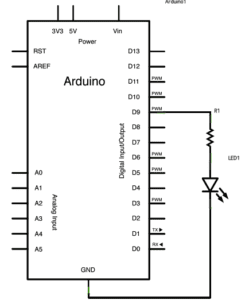September 19, 2019
Recitation 2: Arduino Basics
by: Lifan Yu (ly1164)
Materials:
From Arduino Kit:
1 * Arduino Uno
1 * USB A to B cable
1 * breadboard
1 * buzzer
2 * LEDs
2 * 220 ohm resistors
2 * 10K ohm resistors
2 * pushbuttons
A handful of jumper cables
From cart:
2 * arcade buttons
1 * Multimeter (optional)
Circuit 1: fade
According to instructions I chose the right code example. I connected circuit correctly. However when I connected my computer with my Arduino and circuit, nothing happened. Then finally, with the help of the instructor, I found out that I didn’t chooe the right port in the “tools” column. After choosing the right port, the light can work properly.

Circuit 2: Tone Melody
The process went smoothly. We successfully made the buzzer work. However, a detail is worth remembering: we should put the buzzer’s two legs diagonally on a breadboard so that they exactly fit into the holes on the breadboard.

Circuit 3: Speed Game
I had trouble understanding the circuit diagram at first. I didn’t know that the thing in the middle was a buzzer. I looked through all my things in the Arduino kit but cannot find something like the buzzer drawn in the diagram. My partner said we should try to put a buzzer on it to see if it can work. Then we made great effort to connect the complexed circuit.
However when we uploaded, nothing happened. I checked if the port was the right one. It was. We examined the circuit for about 3 minutes before an instructor came. The instructor disconnected and then reconnected Arduino to my computer. Then the circuit started working. The instructor told us that we must have done something to the Arduino without knowing it, and reconnecting the Arduino can solve the problem
We tested several times whether the circuit can accurately detect the times the buttons were clicked. We first clicked the left button 1 time more than the right button. In the end, the led lit up on the left. Vise versa. Everything was successfully done.

Question1: Examples of me using technology in my daily life are: using my phone to scan QR codes, write certain codes to draw beautiful diagrams and shapes, using apple pencil and a drawing app to draw pictures on ipad.
In this circuit, I used example codes to send command to an Arduino board, and the arduino board control the circuit connected to it and turn the commands of the codes into actual actions of LEDs and buzzers.
Interaction is the process of imputing, outputting and computing of two actors that communicate with each other. The commands sent to the Arduino are inputs. Such as the times we push the buttons in the two player game. The process of electrical currents running through the circuit computing. The process of the LEDs turning on and off or buzzers playing music according to the commands sent to them is output.
Question 2: The push button doesn’t have a large resistance. Without a resistor with rather large resistance, it may be damaged. Also, if the voltage is too high for other components of the circuit, the circuit may be damaged too. Thus,by using a 10K resistor connected in series with other parts of the circuit, it bears most of the voltage and protects the whole circuit.
Question 3: I would use them to create an interactive artwork with a theme of promoting low carbon way of living. When a person stands in front of a LED screen made of thousands of LEDs, they will be asked a series of questions about their daily carbon production. choices will appear on the LED screen. A reflection of he or she will appear on the screen as a lit-up shape. when he or she answers questions, he or she only need to move his or her hands so his or her reflection on the screen can touch one of the answer choices. After answering all questions, a star-like diagram will appear on the screen to show his or her carbon footprint in different aspects of daily life. LEDs will be put on devices around the area where the person stands. Then diffenent light shows that introduce low-carbon ways of living will be preformed for people with different levels of carbon production(or different kinds of carbon footprint).